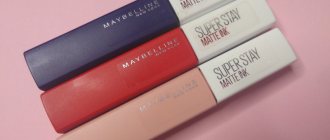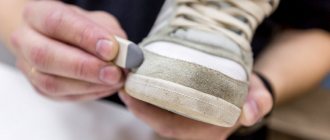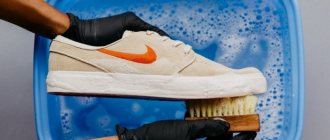The following situation is familiar to most people. You were painting something, you were hot, you were tired... Consequently, various small final tasks (including cleaning brushes) fade into the background, you forget about them. For the next painting, a hard brush with dried paint becomes completely unsuitable. Therefore, you have to either buy a new tool or try to clean it. The choice of solution mainly depends on the price - there is no point in washing cheap brushes, but it is worth trying to clean more expensive ones. Let's find out different ways to clean a brush from paint, returning it to its usability.
What types of brushes are used during painting work?
Every person who has at least once carried out renovations in an apartment on their own is well aware that in order to perform high-quality work, several different types of brushes are required. Thus, priming surfaces, painting ceilings and walls of a room using water-soluble acrylic products requires the use of large flat brushes. For working with oil and some other types of paints, small round or flat brushes, called flutes, are quite suitable.
Types of brushes
In any painting process there are certain breaks, during which the functional properties of the brushes must be preserved in their original state - this will help avoid the need to purchase a new product and save you money and time.
How to remove oil paint?
Dealing with marks left by oil-based paint is not easy. The best results come from trying to remove small drops of still fresh paint - in this case it is enough to simply remove it with a damp cloth. Large areas of recent stains are wiped off with a cotton swab or cloth soaked in vegetable oil. Dried paint can be removed by treating the problem area of the surface with solvents - purified gasoline, alcohol, kerosene, ammonia.
Read also: About witches. The truth and only the truth
Various shapes and sizes, brushes are used for priming and painting walls, ceilings, baseboards, doors and wooden window frames. Used in work, but left for a while in the open air, they may become unusable. The paint sets quickly, the bristles of the brush stick together and in the future it becomes inconvenient, if not completely impossible, to work with such a tool. Are there ways to preserve brushes and clean them of paint after use? And how to clean the brush from paint after repair?
Washing conditioner
Helps remove fresh paint from the bristles. To do this, remove its remains by wiping the brush on paper. The conditioner is mixed with water in equal proportions and the brush is rinsed in the resulting solution until the paint begins to gradually separate from the bristles. Rinse the brush under running warm water. Repeat the procedure until the desired degree of instrument cleaning is achieved.
Take a break from work - save the tool properties
To prevent the brush from losing its properties after a 1-2 hour break in painting, you need to take proper care of it.
There are quite a few types of paints and varnishes that set very quickly, and therefore an unattended brush will be completely covered in a sticky layer in just a couple of hours, which is almost impossible to remove.
Sometimes this option is practiced - the brush is placed with the nap down in a jar filled with water.
However, this method has one significant drawback - although the pile will be saved from thickening the paint, it will become too hard, which is why the quality of further painting work will not be so high.
Therefore, instead of a container with water, it is better to use a regular plastic bag or thin food-grade aluminum foil. To do this, you need to wrap the brush in any of these materials so that air does not get inside. This affordable method will preserve the properties of your brushes for two hours.
Special brush washer
This is a container in the form of a small saucepan with a spring soldered to it on top. Thinner is poured inside, and the brush is fixed in the spring so that its bristles are completely immersed in the product. After cleaning, you can store the brush in the brush tray, but then you add oil instead of solvent. Sunflower or flaxseed will do.
To keep the bristles of the brush soft, it is enough to immerse only the ends of the bristles in the oil.
Cleaning instruments during a long break
If the break between stages of painting work is longer, at least one day, the brushes need to be cared for differently. After painting, leaving them in a jar of solvent for a day is not the best method, since it can lead to deformation of the pile, which will make the subsequent painting process impossible. Therefore, you will have to wash the instrument according to all the rules using special products. If you do not have a professional brush cleaner, prepare the following set of accessories:
- any paint solvent;
- disposable paper towel or piece of soft rag;
- regular laundry soap;
- A container deep enough to immerse brushes.
To thoroughly wash your brushes after painting and ensure proper care for them, you should follow several steps:
- Pour a sufficient amount of solvent into the container.
- Place the brush in the product with the nap facing down and thoroughly soak the lint.
- After this, remove the brush and dry it thoroughly using a rag or paper towel.
- Then the bristles of the products should be thoroughly smeared with soapy foam and washed under running water for several minutes.
All these steps should be repeated until the pile is completely free of paint and varnish materials. This method of care allows you to thoroughly wash the paint, even if it has dried.
Depending on the type of paint used, you need to wash your brushes with different types of solvents. Paints and varnishes that have a water-soluble or adhesive base can be washed with plain water.
And if you have to wash your brush after using oil paint, you should use a special mineral solvent.
Due to the fact that brush cleaning liquid and solvent are products that have a very strong and specific odor, it is advisable to wash these products on the balcony or in the open air. After the procedure is completed, the brush must be thoroughly dried by placing it in a vertical position with the bristles facing up.
Why wash your brushes right away?
Experienced artists know to clean their tools immediately after work. It doesn’t matter how tired you are or how much there is to wash, clean and put away – that’s it.
But newcomers to the world of painting very often neglect this rule, which is why they suffer later. But in vain! After all, cleaning acrylic brushes is as easy as shelling pears, because this paint easily dissolves in water!
Therefore, the first thing you should remember when using acrylic and other paints is to wash your brushes immediately after use!
Other methods
There are other time-tested brush care methods that are very effective. If the paint has not completely dried to the pile, you can wash it using regular fabric softener:
- When starting the procedure, you need to wipe off the excess paint with a soft cloth.
- Then mix conditioner and warm water in equal parts.
- Wash the brush thoroughly in the solution until the paint begins to gradually slide off.
- To consolidate the result, continue to wash the product in warm running water.
- When there are no traces of paint left, the product needs to be thoroughly dried by placing it in a small jar with the nap facing up.
If the paint is too dry, try another method:
- Pour the required amount of vinegar into a convenient container, for example a glass one, and place the brush there for one hour.
- When this period has passed, check how much the paint has softened.
- If the paint has not softened enough, leave the brush in this position for another hour.
- The next step is to take an old saucepan, unsuitable for food purposes, and pour vinegar into it.
- Then place the brush in the pan, place it on the stove, set the flame to medium and wait until it boils.
- The contents of the vessel should continue to boil for several minutes.
- Next, remove the cleaned brush and carefully comb its bristles using a metal brush.
- It is necessary to comb the brush until the smallest particles of paint are completely separated from the bristles.
- Finally, the product should be rinsed in running water and left to dry in a vertical position with the pile facing up.
Regardless of the cleaning method, proper brush care requires moistening the bristles. Any cosmetic conditioner or lotion will be suitable for these purposes. Proper storage of brushes also plays an important role and helps to preserve their properties for as long as necessary.
Removing water-based paints
You can remove a layer of water-based paint at home in several simple ways, including:
- A combination of mechanical treatment with a brush with metal teeth and exposure to ordinary warm water. First, use a brush to leave deep scratches on the surface. Then we wet the roller in warm water and carefully treat the surface. We wait for 10-15 minutes until the paint swells and begins to peel off. Remove it with a metal scraper.
- Wallpaper glue. We take any sheet of paper, apply glue to it, and apply it to the paintwork. We wait until the glue dries. Then remove it using a spatula.
We tidy up suede shoes
Shoe paint is made on a nitro base and can be cleaned with acetone or simple nail polish remover. It is advisable to combat contamination with the help of special solvents 646 and 647. The listed products are applied to a clean cloth and thoroughly wipe the area of the surface damaged by paint.
Baking soda and kitchen cleaners can also remove shoe paint from floors (except linoleum). For this cleaning method, soda is mixed with water to form a slurry, then applied to paint marks and left for 5-10 minutes. Then rub with a damp cloth and wipe dry.
How to remove fresh acrylic paint stains
As soon as a stain appears (less than 60 minutes have passed) on any surface, wash it off with a sponge soaked in a warm soapy solution. Treat the stained area with smooth movements without pressure, starting from the edges and moving towards the center of the stain. After removing marks on clothing, immediately wash the item as usual.
A sponge with soap is the most effective remedy for liquid acrylic paint.
To clean your brushes from acrylic paint, immediately after finishing your work, immerse them in warm water and leave for 20 minutes. Then rinse under running water and dry in the sun.
How to remove dried stains using what you have on hand?
As soon as a stain is discovered, you must immediately begin washing. You should start by removing as much paint as possible from the material.
In this case, it is necessary to act not only quickly, but also extremely carefully:
- the stain should not become larger;
- You cannot “drive” the paint deep into the fibers.
Vinegar, ammonia and soda
To remove paint stains, you need to prepare a cleaning agent from available ingredients taken from the kitchen and from the first aid kit:
- ammonia (1/2 cup);
- vinegar (1/2 cup);
- soda (1 tsp).
Procedure:
- Trying to remove as much paint as possible, rinse the area of contamination with water.
- Mix all prepared ingredients.
- Dip a sponge in the prepared solution and wet the stain well.
- Remove loose paint with a spoon or plastic scraper.
- Rinse the item in plenty of water.
- Wash the product as usual.
It is recommended to clean outdoors or with an open window, as the cleaning solution has a pungent, irritating odor.
Nail polish remover
Nail polish remover can also help remove paint stains.
For this:
- Using a napkin or sponge, apply the product to the area where the paint gets in contact.
- Wait a few minutes.
- Using a brush, carefully remove any remaining stain.
- Cleaning ends with the normal wash cycle.
If the paint stain is small, you can use an old toothbrush to scrub it off.
Dishwashing liquid
This method is suitable for fresh stains. After as much paint as possible has been removed from the clothing, you must perform the following steps:
- Blot the fabric with a napkin.
- Turn the item inside out.
- Rinse the contaminated area with plenty of cool water, directing the stream from the inside out.
- Wash the affected area of fabric using dishwashing detergent.
- If the density of the material allows, you can rub the stain with a brush.
- Dilute dishwashing detergent in a container of cool water.
- Soak items for no more than 4 hours.
- Rinse the product manually or using a washing machine.
This cleaning option is only suitable if the stain is not only fresh, but also small in size.
How to remove with tape?
Regular craft tape can be used to remove dry paint and cotton fabric.
To do this, a strip of tape is carefully glued to the problem area of the clothing using smoothing movements. After this, carefully peel off the tape. Do not peel the tape off the fabric with a jerk.
Isopropyl alcohol
Isopropyl alcohol can be used as a quick response agent.
The order of work in this case is as follows:
- Soak the stained area with alcohol.
- Mechanically scrape off as much paint as possible using, for example, a spoon.
- Remove small paint residues with a toothpick.
- Wash the product as usual using washing powder.
The stain removal process may need to be repeated if acrylic paint still remains.
How to clean with gasoline, acetone or white spirit
In cases where the acrylic paint stain was not detected immediately and had time to dry, you will have to use one of the solvents:
- white alcohol;
- acetone;
- gasoline.
Stain removal should be carried out in stages:
- Spread the item out on a flat surface.
- Moisten the prepared sponge in paint thinner.
- Treat the stain with gentle movements, avoiding smearing the paint.
- The mark left on the fabric after treatment must be washed with laundry soap.
- Rinse clothes in clean water.
- Wash the entire item.
If the stain is large, then use a sponge soaked in solvent to work from the edges to the middle of the stain.
Sunflower oil and laundry soap
To work on removing a fresh stain you will need:
- sunflower oil;
- laundry soap;
- water.
Procedure:
- Rub the stain with sunflower oil using a sponge or napkin.
- Grate ½ bar of laundry soap.
- Dilute soap shavings in 4 liters of water.
- Soak the item.
- Leave for a quarter of an hour.
- Rub the stained area and rinse the clothes.
- Wash the product as usual.
Sunflower oil can leave greasy stains on clothes. If they cannot be avoided, washing them with dishwashing detergent will help.
How to store clean brushes
There are several rules for storing brushes used for oil paint:
- Before storage, the brushes need to be adjusted in shape - this is usually done with your fingers.
- If the instrument is stored vertically, then only with the bristles down, so that moisture does not flow under the metal base. Can also be stored horizontally.
- When placing brushes in a closed box, they must be completely dry. Remaining moisture leads to mold. But you can also place wet ones in an open container.
- To make the tool last longer, it is treated with conditioner. This one is sold in art stores. But conditioner moistens the bristles, so it is not suitable if you need dry brushes when painting.
Also, clean brushes can be stored in a brush rack. Linseed or sunflower oil is poured inside, and the brush is dipped into it, covering only the bristles.
If the wallpaper is stained
Was the wallpaper damaged while painting the baseboard, floor, doors or ceiling? In this case, it is possible to correct the situation if the paint has not yet dried. How to remove paint from wallpaper? The best option is to immediately blot the stained area with a damp sponge and leave until dry.
Vegetable oil can also help remove paint from wallpaper - to do this, soak a clean cloth in oil, apply it to the stain for a while, and then remove it with light blotting movements.
It is almost impossible to remove dried paint from wallpaper without damaging it. The solution to the problem will be to replace the stained section of wallpaper or skillfully decorate the walls to hide the repair misunderstanding.
Features of the composition
Acrylic paint is applied to various surfaces, including:
- tree;
- fabrics;
- plastic;
- concrete;
- brick;
- glass.
During construction and renovation, multifunctional coating is used for both external and internal work. The choice of paint color is practically unlimited. In addition, it does not flow down on vertical planes, fits well, and does not form any streaks or unevenness.
Read also: Why a guppy cannot give birth
The paint is safe for people, it can even be used in children's rooms. An undoubted advantage is the ability of the coating to allow air to pass through and resist moisture. On surfaces treated with acrylic paints, mold does not appear and fungus does not grow.
Unlike oil paint, acrylic paint is odorless, dries quickly and does not crack. It is not surprising that it is preferred in most cases when renovating residential, industrial and office premises. The excellent characteristics of paints are due to their composition. The composition may differ slightly from one manufacturer to another. However, for all paints belonging to this category, the following ingredients are required:
- binder base;
- acrylic fillers;
- pigments;
- additional additives.
The binding base plays the main role: it unites all the substances included in a single composition. The base is a water-soluble polymer material. To produce the main component, acrylic resin is required. The base provides the paint with color fastness.
Nitrosolvents
Pour a small amount of thinner into the jar (it should penetrate the bristles of the brush; this can be helped by pressing the brush against the side of the jar). Leave the brush for 2 hours and dry with a clean cloth. Store in a dry place until further use.
Thinner should not be poured into the sink. After cleaning the brushes, close the jar with a lid and leave it for 24 hours. Once the washed-out paint has settled to the bottom, pour the remaining solvent into the bottle for later use. Wait until the residue at the bottom is completely dry, then throw it away. Try using the smallest can, therefore the smallest amount of thinner – the planet will thank you!
1.2. Using fabric softener
The cleaning procedure is as follows:
- prepare a cleaning solution from 120 ml of conditioner and 4 liters of water;
- remove paint residues with a paper towel or cloth rag;
- wash thoroughly in the prepared solution;
- by shaking or using paper or fabric waste, remove any remaining solution;
- straighten and dry the brush bristles.
General recommendations
Blot excess paint with a cloth or soft napkin. For greater effectiveness, you can gently squeeze the hairs with your fingers or a cloth in the direction from the cartridge to the ends, being careful not to pull them. If you painted with oil paints, rinse your brush in turpentine or oil. When using water-soluble pigments, warm water will be sufficient. Never use hot water. This will cause the cartridge to expand, causing hairs to fall out. Blot the brush again with a cloth, removing any remaining paint. Rinse the brush carefully in a mild solution of soap or dishwashing detergent. Lightly rub the lint with a bar of soap, then work the foam onto a surface or your palm if you are not using any toxic solvents or pigments. Rinse the hairs and repeat until the dye of any color stops washing out. Over time, your brush will get dirty, but don't stop rinsing it until you're sure it's clean. Don't use brute force. Be patient and rinse the brush several times. Rinse off any remaining soap with warm water. Shake off moisture from the pile. Try to give the hairs the desired shape with your fingers. If necessary, wrap the wet brush in a napkin or toilet paper. As the paper dries, it will shrink, giving the stubble the desired silhouette. Leave the brush to dry at room temperature
Please note that it should not stand with the pile down, otherwise the form will be damaged after drying. Place the brush horizontally or vertically on the tip of the handle
You shouldn't dry too many brushes together so that they don't get crowded. If you are concerned about the toxicity of the paint you are using, or if it stains your hands while washing, wear gloves. You can also try the Bob Ross Painters Glove.











